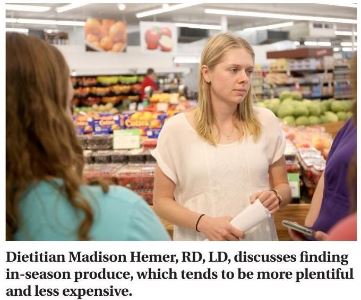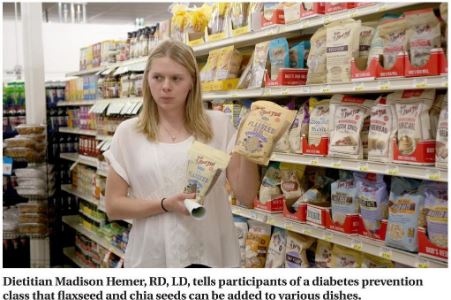posted
on 6/9/2021
in
Features
By REBECCA MCKINSEY r.mckinsey@carrollspaper.com Carroll Times Herald, June 8, 2021, Summer Edition of Health View
.jpg)
On a recent tour through Fareway grocery store in Carroll with members of a diabetes prevention class, Madison Hemer, RD, LD with St. Anthony Regional Hospital, offered the following guidelines for people with diabetes, those seeking to prevent it or anyone who wants to shop and cook in ways that promote a healthy diet.
AVOID IMPULSE BUYING
Make a list before you shop, and stick to it. Avoid foods and items grouped near the front of the store and at the checkout — they’re often unhealthy and meant to distract.
“Marketing psychology is a real thing, and grocery stores are really good at that,” Hemer said.
FRESH PRODUCE
Find out what produce is in season at different times of the year. It normally will be more plentiful and affordable. Apps such as “Spend Smart. Eat Smart.” provide information such as how to tell if produce is ripe. Compare unit prices, such as the price per ounce of bagged lettuce versus a head of lettuce.
Hemer noted that grocery stores often display organic fruits and vegetables separately, and those options sometimes cost more.

“Organic doesn’t necessarily mean healthier,” she said. “It’s just grown in a different way, without chemicals or pesticides, so that’s your choice.”
MEATS AND FISH
Trans fats and saturated fats are more unhealthy; look at the labels on packaged meats. Lean meats such as turkey, chicken, fish and lean beef are low in saturated fats. Leaner beef — for instance, 90 percent lean meat to 10 percent fat — is more expensive, but you’re getting more meat for the cost.
Hemer suggested a simple way to gauge the amount of saturated fats in meats: the more legs the animal has, the more saturated fat it will have. Beef or pork tend to have more, while chicken and turkey have less, and fish less still.
DAIRY
Low-fat milk has the same amount of calcium in each service as 2 percent or whole milk, but less fat and fewer calories. Look out for how much added sugar is in yogurt. Cheese is a good snack but is higher in calories; watch portion sizes.
BREAD
Look for bread that lists “whole wheat” as the first ingredient. Other labels, such as multigrain or stone ground, might sound healthy but don’t offer the same benefits.

LEGUMES
These include beans and lentils and offer plant-based protein. They can be purchased dried or canned. Dried beans take more time to prepare, as they need to be soaked, but they can be more cost-effective. Look for low-sodium or no-salt added options when buying cans, and rinse the beans with water after opening the can.
CEREAL
Look for cereal options with the lowest amounts of added sugar. Look for cereals with whole grains. Pay attention to serving sizes.
Hemer pointed out the various ways cereal is marketed: the “fun-looking” boxes usually have more sugar; the most-healthy options are placed all the way at the top, while sugary options are in the bottom rows at kids’ eye level.
FRUIT JUICE, SPORTS DRINKS AND CARBONATED BEVERAGES
Chose fruit juices that are “100 percent fruit juice.” Pay attention to the amount of added sugars and limit them as much as possible.
Look at the sugar content in sports drinks and carbonated beverages. The most-basic fruit-flavored seltzer waters with no sugars or artificial sweeteners are a good replacement for soda for some people, although some don’t like the taste — Hemer joked her father calls them “dirt water.”
“Your beverages can be a big source of calories,” she said. “Paying attention to them can help you eliminate a lot of calories.”
MISCELLANEOUS
- Check for the amount of sodium in canned soups.
- Purchase tuna canned in water, not oil.
- Canned fruits and vegetables can be lower in price than fresh produce. For fruits, look for fruit canned in fruit juice, not light or heavy syrup, and without added sugars. Fruit canned in syrup can be rinsed to remove some of the extra sugar. For vegetables, look for low-sodium or no-salt-added options and rinse the veggies before using. Shoot for 150 mg of salt or less, or 5 percent of the daily allowance, per product. When cooking vegetables, consider flavoring other than salt, including garlic salt, lemon or lime juice, or herbs.
- It’s good to have frozen vegetables on hand to easily add veggies to a variety of meals.
- Frozen meals can be an inexpensive option, but pay attention to sodium content and aim for 600 mg or less of sodium per frozen meal.
- Processed snack foods such as chips or fruit snacks often contain little nutritional value. Try replacing chips with popcorn or nuts and fruit snacks with real fruit.
- Flaxseed and chia seeds make good additives to yogurt, toast, smoothies and other dishes. Flaxseed should be ground to aid digestion.
Hemer emphasized looking at nutrition labels and ingredients.
“I’m not going to say what specific foods to buy, but knowing what’s in your food is a really good tool,” she said.
The diabetes prevention class is one of the programs offered through the St. Anthony Chronic Care Center. Learn more at www.stanthonyhospital.org/services/chronic-care-center/diabetes-prevention-program.
Filter
- chronic care center
- diabetes
- diabetes prevention program
- diabetes services
- dietitian